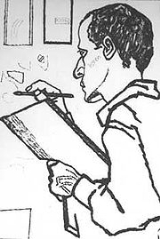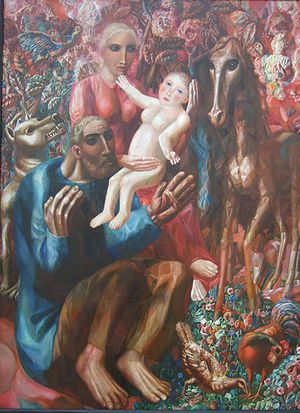
Pavel Filonov
Encyclopedia
Pavel Nikolayevich Filonov (January 8, 1883 – December 3, 1941) was a Russian avant-garde
painter, art theorist, and poet.
) or December 27, 1882 (Julian calendar
). In 1897, he moved to St. Petersburg
where he took art lessons. In 1908, he entered St. Petersburg Academy of Arts
, from which he was expelled in 1910.
In 1910–1914, he took part in the arts group Soyuz Molodyozhi
created by artists Elena Guro
and Mikhail Matyushin
. In 1912, he wrote the article The Canon and the Law, in which he formulated the principles of analytical realism, or "anti-Cubism". According to Filonov, Cubism
represents objects using elements of their surface geometry but "analytical realists" should represent objects using elements of their inner soul. He was faithful to these principles for the remainder of his life.
 During the years 1913 to 1915, Filonov was close to Vladimir Mayakovsky
During the years 1913 to 1915, Filonov was close to Vladimir Mayakovsky
, Velimir Khlebnikov
, and other futurists
. In the autumn of 1916, he enlisted for service in World War I and served on the Romania
n front. Filonov participated actively in the Russian Revolution of 1917
and served as the Chairman of the Revolutionary War Committee of Dunay region.
In 1919, he exhibited in the First Free Exhibit of Artists of All Trends at the Hermitage
. In 1923, he became a professor of St. Petersburg Academy of Arts and a member of the Institute for Artistic Culture (INKhUK). He organized a large arts school of Masters of Analytical Realism (over seventy artists). Their work influenced suprematism
and expressionism
.
In 1929, a large retrospective exhibition of Filonov art was planned at the Russian Museum
; however, the Soviet government forbade the exhibition from going forward. From 1932 onward, Filonov literally starved but still refused to sell his works to private collectors. He wanted to give all his works to the Russian Museum as a gift so as to start a Museum of Analytical Realism. He died of starvation on December 3, 1941 during the Nazi Siege of Leningrad
.
, Filonov put forth a manner of working that proceeded from the particular to the general. He believed that objects and fields should be built up from small details and bits and stated that doing it the other-way-round was nothing short of "charlatanism". To this end, he worked, and required his students to work, with very small brushes in painting and the finest of points when drawing.
 Most of Filonov's works were saved by his sister Yevdokiya Nikolayevna Glebova. She stored the paintings in the Russian Museum's archives and eventually donated them as a gift. Exhibitions of Filonov's work were forbidden. In 1967, an exhibition of Filonov's works in Novosibirsk
Most of Filonov's works were saved by his sister Yevdokiya Nikolayevna Glebova. She stored the paintings in the Russian Museum's archives and eventually donated them as a gift. Exhibitions of Filonov's work were forbidden. In 1967, an exhibition of Filonov's works in Novosibirsk
was permitted. In 1988, his work was allowed in the Russian Museum. In 1989 and 1990, the first international exhibition of Filonov's work was held in Paris.
During the period of half-legal status of Filonov's works it was seemingly easy to steal them; however, there was a legend that Filonov's ghost protected his art and anybody trying to steal his paintings or to smuggle them abroad would soon die, become paralyzed, or have a similar misfortune.
Russian avant-garde
The Russian avant-garde is an umbrella term used to define the large, influential wave of modern art that flourished in Russia approximately 1890 to 1930 - although some place its beginning as early as 1850 and its end as late as 1960...
painter, art theorist, and poet.
Biography
Filonov was born in Moscow on January 8, 1883 (Gregorian calendarGregorian calendar
The Gregorian calendar, also known as the Western calendar, or Christian calendar, is the internationally accepted civil calendar. It was introduced by Pope Gregory XIII, after whom the calendar was named, by a decree signed on 24 February 1582, a papal bull known by its opening words Inter...
) or December 27, 1882 (Julian calendar
Julian calendar
The Julian calendar began in 45 BC as a reform of the Roman calendar by Julius Caesar. It was chosen after consultation with the astronomer Sosigenes of Alexandria and was probably designed to approximate the tropical year .The Julian calendar has a regular year of 365 days divided into 12 months...
). In 1897, he moved to St. Petersburg
Saint Petersburg
Saint Petersburg is a city and a federal subject of Russia located on the Neva River at the head of the Gulf of Finland on the Baltic Sea...
where he took art lessons. In 1908, he entered St. Petersburg Academy of Arts
Imperial Academy of Arts
The Russian Academy of Arts, informally known as the St. Petersburg Academy of Arts, was founded in 1757 by Ivan Shuvalov under the name Academy of the Three Noblest Arts. Catherine the Great renamed it the Imperial Academy of Arts and commissioned a new building, completed 25 years later in 1789...
, from which he was expelled in 1910.
In 1910–1914, he took part in the arts group Soyuz Molodyozhi
Soyuz Molodyozhi
Soyuz Molodyozhi was an artistic group and an art magazine of Russian avant-garde organized in 1910.There were more than 30 members of the group and most of other Russian avant-garde participated in their exhibitions....
created by artists Elena Guro
Elena Guro
Elena Genrikhovna Guro was a Russian Futurist painter, playwright, poet, and writer of fiction.-Early life:Guro was born in St. Petersburg on January 10, 1877. Her father was Genrikh Stepanovich Guro, an officer in the Imperial Russian Army of French descent. Her mother Anna Mikhailovna...
and Mikhail Matyushin
Mikhail Matyushin
Michael Vasilyevich Matyuschin was a Russian painter and composer, leading member of the Russian avant-garde. In 1910–1913 Matyushin and his wife Elena Guro were key members of the Union of the Youth, an association of Russian Futurists...
. In 1912, he wrote the article The Canon and the Law, in which he formulated the principles of analytical realism, or "anti-Cubism". According to Filonov, Cubism
Cubism
Cubism was a 20th century avant-garde art movement, pioneered by Pablo Picasso and Georges Braque, that revolutionized European painting and sculpture, and inspired related movements in music, literature and architecture...
represents objects using elements of their surface geometry but "analytical realists" should represent objects using elements of their inner soul. He was faithful to these principles for the remainder of his life.

Vladimir Mayakovsky
Vladimir Vladimirovich Mayakovsky was a Russian and Soviet poet and playwright, among the foremost representatives of early-20th century Russian Futurism.- Early life :...
, Velimir Khlebnikov
Velimir Khlebnikov
Velimir Khlebnikov , pseudonym of Viktor Vladimirovich Khlebnikov , was a central part of the Russian Futurist movement, but his work and influence stretch far beyond it.Khlebnikov belonged to Hylaea,...
, and other futurists
Russian Futurism
Russian Futurism is the term used to denote a group of Russian poets and artists who adopted the principles of Filippo Marinetti's "Manifesto of Futurism"...
. In the autumn of 1916, he enlisted for service in World War I and served on the Romania
Romania
Romania is a country located at the crossroads of Central and Southeastern Europe, on the Lower Danube, within and outside the Carpathian arch, bordering on the Black Sea...
n front. Filonov participated actively in the Russian Revolution of 1917
Russian Revolution of 1917
The Russian Revolution is the collective term for a series of revolutions in Russia in 1917, which destroyed the Tsarist autocracy and led to the creation of the Soviet Union. The Tsar was deposed and replaced by a provisional government in the first revolution of February 1917...
and served as the Chairman of the Revolutionary War Committee of Dunay region.
In 1919, he exhibited in the First Free Exhibit of Artists of All Trends at the Hermitage
Hermitage Museum
The State Hermitage is a museum of art and culture in Saint Petersburg, Russia. One of the largest and oldest museums of the world, it was founded in 1764 by Catherine the Great and has been opened to the public since 1852. Its collections, of which only a small part is on permanent display,...
. In 1923, he became a professor of St. Petersburg Academy of Arts and a member of the Institute for Artistic Culture (INKhUK). He organized a large arts school of Masters of Analytical Realism (over seventy artists). Their work influenced suprematism
Suprematism
Suprematism was an art movement focused on fundamental geometric forms which formed in Russia in 1915-1916. It was not until later that suprematism received conventional museum preparations...
and expressionism
Expressionism
Expressionism was a modernist movement, initially in poetry and painting, originating in Germany at the beginning of the 20th century. Its typical trait is to present the world solely from a subjective perspective, distorting it radically for emotional effect in order to evoke moods or ideas...
.
In 1929, a large retrospective exhibition of Filonov art was planned at the Russian Museum
Russian Museum
The State Russian Museum is the largest depository of Russian fine art in St Petersburg....
; however, the Soviet government forbade the exhibition from going forward. From 1932 onward, Filonov literally starved but still refused to sell his works to private collectors. He wanted to give all his works to the Russian Museum as a gift so as to start a Museum of Analytical Realism. He died of starvation on December 3, 1941 during the Nazi Siege of Leningrad
Siege of Leningrad
The Siege of Leningrad, also known as the Leningrad Blockade was a prolonged military operation resulting from the failure of the German Army Group North to capture Leningrad, now known as Saint Petersburg, in the Eastern Front theatre of World War II. It started on 8 September 1941, when the last...
.
Method
Under the umbrella of Universal FloweringUniversal Flowering
Universal Flowering is the name given by Pavel Filonov to his system of analytical art. The system arose from cubo-futurist experiments and works that he undertook from 1913-1915...
, Filonov put forth a manner of working that proceeded from the particular to the general. He believed that objects and fields should be built up from small details and bits and stated that doing it the other-way-round was nothing short of "charlatanism". To this end, he worked, and required his students to work, with very small brushes in painting and the finest of points when drawing.
Legacy

Novosibirsk
Novosibirsk is the third-largest city in Russia, after Moscow and Saint Petersburg, and the largest city of Siberia, with a population of 1,473,737 . It is the administrative center of Novosibirsk Oblast as well as of the Siberian Federal District...
was permitted. In 1988, his work was allowed in the Russian Museum. In 1989 and 1990, the first international exhibition of Filonov's work was held in Paris.
During the period of half-legal status of Filonov's works it was seemingly easy to steal them; however, there was a legend that Filonov's ghost protected his art and anybody trying to steal his paintings or to smuggle them abroad would soon die, become paralyzed, or have a similar misfortune.

